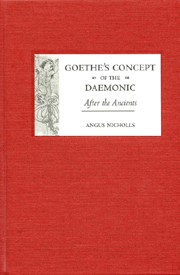Book contents
- Frontmatter
- Contents
- Editions and Abbreviations
- Acknowledgments
- Introduction
- 1 The Ancients and Their Daemons
- 2 The Daemonic in the Philosophy of the Sturm und Drang: Hamann and Herder
- 3 Romanticism and Unlimited Subjectivity: “Mahomets Gesang”
- 4 Werther: The Pathology of an Aesthetic Idea
- 5 Kantian Science and the Limits of Subjectivity
- 6 Schelling, Naturphilosophie, and “Mächtiges Überraschen”
- 7 After the Ancients: Dichtung und Wahrheit and “Urworte. Orphisch”
- 8 Eckermann, or the Daemonic and the Political
- Epilogue: Socrates and the Cicadas
- Works Cited
- Index
Epilogue: Socrates and the Cicadas
Published online by Cambridge University Press: 05 February 2013
- Frontmatter
- Contents
- Editions and Abbreviations
- Acknowledgments
- Introduction
- 1 The Ancients and Their Daemons
- 2 The Daemonic in the Philosophy of the Sturm und Drang: Hamann and Herder
- 3 Romanticism and Unlimited Subjectivity: “Mahomets Gesang”
- 4 Werther: The Pathology of an Aesthetic Idea
- 5 Kantian Science and the Limits of Subjectivity
- 6 Schelling, Naturphilosophie, and “Mächtiges Überraschen”
- 7 After the Ancients: Dichtung und Wahrheit and “Urworte. Orphisch”
- 8 Eckermann, or the Daemonic and the Political
- Epilogue: Socrates and the Cicadas
- Works Cited
- Index
Summary
Keeping in mind Goethe's admission that he uses the term daemonic “nach dem Beispiel der Alten,” it is useful to return in these concluding remarks to the ancient philosopher whose discussion of the daemonic is more detailed and comprehensive than that of any other figure in the canon of classical philosophy: Plato. In their eagerness to interpret one of the most famous appearances of the Socratic daimonion — at 242b–c of Plato's Phaedrus — many commentators have overlooked the pastoral setting of this dialogue. Socrates and Phaedrus are walking outside of the walls of Athens, and Socrates himself takes some time (at 230b–c) to describe the scene of their conversation. It is, he observes,
a delightful resting place, with this tall spreading plane [tree], and a lovely shade from the high branches of the agnos. Now that it's in full flower, it will make the place ever so fragrant. And what a lovely stream under the plane tree, and how cool to the feet! … And then too, isn't the freshness of the air most welcome and pleasant, and the shrill summery music of the cicada choir.
(PCD, 478–79)Later in the dialogue, the story behind the most striking aspect of this setting — the “cicada choir” — is revealed. At 258e–259d we learn that the cicadas were in fact once, before the birth of the Muses, human beings.
- Type
- Chapter
- Information
- Goethe's Concept of the DaemonicAfter the Ancients, pp. 263 - 270Publisher: Boydell & BrewerPrint publication year: 2006



